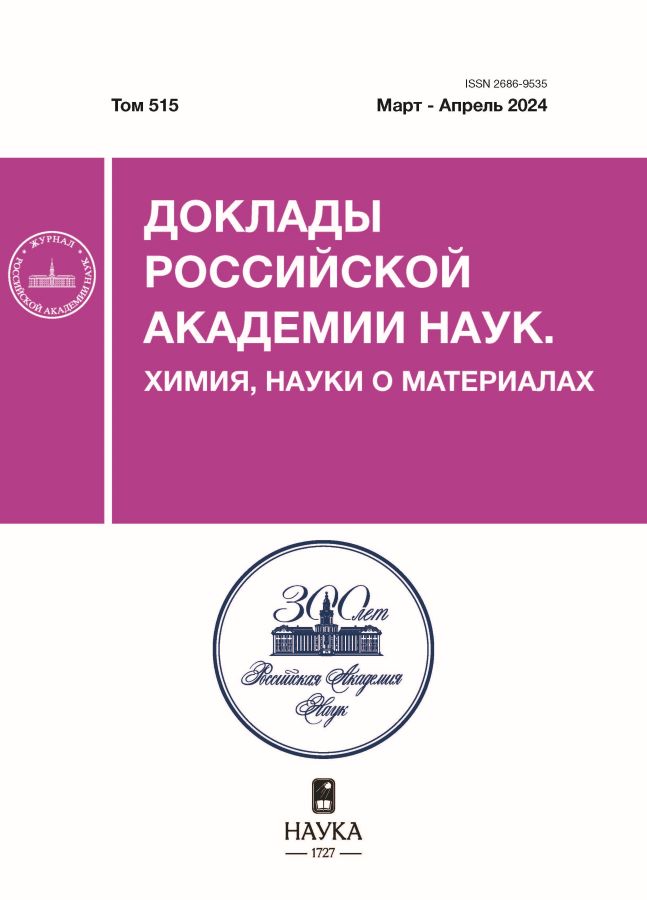Thermodynamic functions of Tm2O3‧2HfO2 solid solution and Shottky anomaly
- 作者: Guskov А.V.1, Gagarin P.G.1, Guskov V.N.1, Khoroshilov А.V.1, Gavrichev K.S.1
-
隶属关系:
- Kurnakov Institute of General and Inorganic Chemistry, Russian Academy of Sciences
- 期: 卷 515, 编号 1 (2024)
- 页面: 54-64
- 栏目: PHYSICAL CHEMISTRY
- URL: https://ter-arkhiv.ru/2686-9535/article/view/651915
- DOI: https://doi.org/10.31857/S2686953524020064
- EDN: https://elibrary.ru/zrvgla
- ID: 651915
如何引用文章
详细
The molar heat capacity of the solid solution Tm2O3‧2HfO2 has been determined for the first time by relaxation, adiabatic and differential scanning calorimetry, the temperature dependences of entropy and enthalpy increment in the temperature region 0–1800 K have been calculated, and the contribution to the heat capacity of the Schottky anomaly at 0–300 K has been evaluated.
全文:
作者简介
А. Guskov
Kurnakov Institute of General and Inorganic Chemistry, Russian Academy of Sciences
Email: guskov@igic.ras.ru
俄罗斯联邦, 119991, Moscow
P. Gagarin
Kurnakov Institute of General and Inorganic Chemistry, Russian Academy of Sciences
Email: guskov@igic.ras.ru
俄罗斯联邦, 119991, Moscow
V. Guskov
Kurnakov Institute of General and Inorganic Chemistry, Russian Academy of Sciences
编辑信件的主要联系方式.
Email: guskov@igic.ras.ru
俄罗斯联邦, 119991, Moscow
А. Khoroshilov
Kurnakov Institute of General and Inorganic Chemistry, Russian Academy of Sciences
Email: guskov@igic.ras.ru
俄罗斯联邦, 119991, Moscow
K. Gavrichev
Kurnakov Institute of General and Inorganic Chemistry, Russian Academy of Sciences
Email: guskov@igic.ras.ru
俄罗斯联邦, 119991, Moscow
参考
- Шевченко А.В., Лопато Л.М., Кирьякова И.Е. // Изв. АН СССР. Неорган. матер. 1984. Т. 20. С. 1991–1996.
- Andrievskaya E.R. // J. Europ. Ceram. Soc. 2008. V. 28. P. 2363–2388. https://doi.org/10.1016/jeurceramsoc.2008.01.009
- Duran P., Pascual C.J. // Mater. Sci. 1984. V. 19. P. 1178–1184. https://doi.org/10.1007/bf01120027
- Trubelja M.F., Stubican V.S. // J. Am. Ceram. Soc. 1988. V. 71. P. 662–666. https://doi.org/10.1111/j.1151–2916.1988.tb06385.x
- Yokokawa H., Sakai N., Kawada T., Dokiy M.J. // Am. Ceram. Soc. 1990. V. 73. P. 649–658. htps://doi.org/10.1111/j.1151–2916.1990.tb06567.x
- Subramanian M.A., Aravamudan G., Subba Rao G.V. // Prog. Solid State Chem. 1983. V. 15. P. 55–143. htts://doi.org/10.1016/0079–6786(83)90001–8
- Banchard P.E.R., Liu S., Kennedy B.J., Ling C.D., Avdeev M., Aitken J.B., Cowie B.C.C., Tadich A.J. // Phys. Chem. C. 2013. V. 117. P. 2266–2273. https://doi.org/10.1021/jp311329q
- Gagarin P.G., Guskov A.V., Guskov V.N., Tyurin A.V., Khoroshilov A.V., Gavrichev K.S. // Ceram. Int. 2021. V. 47. P. 2892–2896. https://doi.org/10.1016/j.ceramint.2020.09.072
- Портной К.И., Тимофеева Н.И., Салибеков С.Е., Романович И.В. // Изв. АН СССР. Неорган. матер. 1970. Т. 6. С. 91–95.
- Voskov A.L., Kutsenok I.B., Voronin G.F. // Calphad. 2018. V. 61. P. 50–61. https//doi.org/10.1016/j.calphad.2018.02.001
- Voronin G.F., Kutsenok I.B. // J. Chem. Eng. Data. 2013. V. 58. P. 2083–2094. https:/doi.org/10.1021/je400316m
- Гуськов А.В., Гагарин П.Г., Гуськов В.Н., Тюрин А.В., Гавричев К.С. // ЖФХ. 2022. Т. 96. С. 1230–1239. https:/doi.org/31857.S0044445372209014X
- Гуськов А.В., Гагарин П.Г., Гуськов В.Н., Тюрин А.В., Гавричев К.С. // Докл. РАН. Химия, науки о материалах. 2021. Т. 498. С. 83–87. https://doi.org/31857.S2686953521050083
- Tari A. The specific heat of matter at low temperatures. London, Imperial College Press, 2003. 211 p. https://oi.org/10.1142/9781860949395_0006
- Zhou H.D., Wiebe C.R., Janik J.A., Balicas L., Yo Y.J., Qiu Y., Copley J.R.D., Gardner J.S. // Phys. Rev. Lett. 2008. V. 101. 227204. https://doi.org/10.1103/PhysRevLett.101.227204
- Westrum E.F. Jr. // J. Therm. Anal. 1985. V. 30. P. 1209–1215. https://doi.org/10.1007/BF01914288
- Chirico R.D., Westrum E.F. Jr. // J. Chem. Thermodyn. 1980. V. 12. P. 71–85. https://di.org/10.1016/0021–9614(80)90118–4
- Ji Y., Beridze G., Bosbach D., Kowalski P.M. // J. Nucl. Mater. 2017. V. 494. P. 172–181. http://dx.doi.org/10.1016/j.jnucmat.2017.07.026
- Konings R.J.M., Beneš O., Kovács A., Manara D., Sedmidubský D., Gorokhov L., Iorish V.S., Yungman V., Shenyavskaya E., Osina E.J. // Phys. Chem. Refer. Data. 2014. V. 43. 013101. https://doi.org/10.1063/1.4825256
- Pankratz L.B. Thermodynamic properties of elements and oxides. Washington, D.C., U.S. Dept. of the Interior, Bureau of Mines, 1982. V. 672. 509 p.
补充文件















